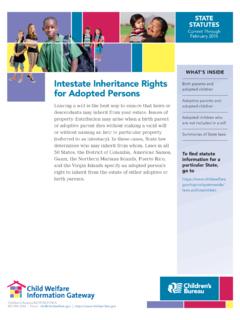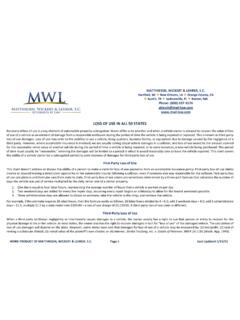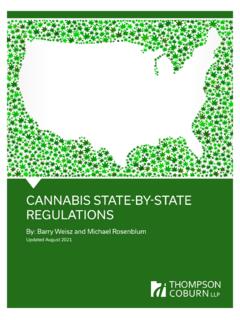Transcription of Agency Manual of
1 Agency Manual of Accreditation Policy and Procedure Revised September 2007 2 American Correctional Association Standards and Accreditation Department Staff Directory Mark A. Flowers Director Jeffrey D. Crawford, Accreditation Specialist E-mail: Phone: 703-224-0075 Areas of Responsibility: Arizona, Arkansas, Connecticut, Kentucky, Massachusetts, New York, Canada, Cornell Corrections, Corrections Corporation of America, Department of Homeland Security, Federal Bureau of Prisons, The GEO Group, Inc., Military facilities Cecil Patmon, Accreditation Specialist E-mail: Phone: 703-224-0072 Areas of Responsibility: Alabama, California, Delaware, District of Columbia, Florida, Hawaii, Indiana, kansas , Minnesota, Missouri, New Hampshire, New Jersey, Oklahoma, Oregon, Virginia, Washington, Wisconsin, Wyoming, West Virginia Nicole Spann, Accreditation Specialist E-mail: Phone: 703-224-0074 Areas of Responsibility.
2 Alaska, Colorado, Georgia, Idaho, Illinois, Iowa, Louisiana, Maryland, Maine, Michigan, Montana, Nebraska, Nevada, New Mexico, North Carolina, North Dakota, Ohio, Pennsylvania, Puerto Rico, Rhode Island, South Carolina, South Dakota, Tennessee, Texas, Utah, Vermont Leslee Hunsicker, Healthcare Administrator E-mail: Phone: 703-224-0076 3 Table of Contents Staff Directory 2 Overview of the American Correctional Association 6 Organizational Purposes of the American Correctional Association 7 Overview of the Commission on Accreditation for Corrections 8 Association staff 8 Auditors 9 Standards Development 9 The Accreditation Process 12 Accountability 12 Confidentiality 13 Eligibility Criteria 13 Application Process 14 Selecting the Appropriate Manual of Standards 15 Fees 15 Agency Withdrawal 15 Correspondent Status 16 Agency Organization and Activities 16 The Accreditation Manager 17 Orientation for Agency Personnel 17 The
3 Work Plan 18 Outcome Measures 19 Significant Incident Summary 19 Developing Documentation 20 Setting Up Files 21 Standards Compliance Checklists 21 Expected Practices 21 Process Indicators 22 Application of Revised Standards 22 Non-applicable Standards 22 Technical Assistance 24 Mock Audits 25 The Self-Evaluation Report 26 Compliance Tally 26 Submission of the Self-Evaluation Report 26 4 Candidate Status 27 Audit Request and Arrangements 27 Final Agency Preparation 27 The Visiting Committee 28 Conduct of the Standards Compliance Audit 30 Entrance Interview 30 Agency Tour 31 Standards Compliance Review 31 Interviews 33 Exit Interview 34 Audits of Probation and/or Parole Agencies 34 Central Office Review of System-wide Policies and Procedures 35 Re-audit 36 The Visiting Committee Report 37 Report Elements 37 Non-compliant Standards 38 Plans of Action 38 Waivers 39 Appeals 40 Discretionary Compliance 40 Accreditation Hearings 42 Conduct of Hearings 42 Accreditation Decisions 44 Appeal Process 44 Accredited Status 46 Annual Report 46 Monitoring Visits 47 Revocation of Accreditation 48 Expiration of Accredited Status 49 Reaccreditation 50 Eligibility 50 Activities 50 Standards
4 Compliance Reaccreditation Audit 51 Visiting Committee Report 51 Accreditation Hearing 51 5 Appendices Appendix A - Proposal for Standard Revision Form 52 Appendix B - Notice of Application for Accreditation 54 Appendix C - Organization Summary 55 Appendix D - Standards Compliance Checklist 59 Appendix E - Compliance Tally 60 Appendix F - Response to Non-compliance 61 Appendix G - Significant Incident Summary 63 Glossary 64 6 Overview of the American Correctional Association The American Correctional Association is the oldest and most prestigious correctional membership organization in the United States. Founded in 1870, ACA currently represents more than 20,000 correctional practitioners in the United States and Canada.
5 Members include all levels of staff from a wide variety of correctional disciplines and programs, as well as professionals in allied fields and representatives from the general public. In addition, the Association represents the interests of 74 affiliated organizations whose goals, while similar to those of ACA, focus on specialized fields and concerns within the realm of corrections. At its first organizational meeting held in Cincinnati, Ohio, in 1870, the Association elected then-Ohio governor and future President, Rutherford B. Hayes, as its first president. The Declaration of Principles developed at that first meeting became the guidelines for correctional goals in both the United States and Europe.
6 Since that time, ACA has continued to take a leadership role in corrections and work toward a unified voice in correctional policy. In recent years, one of the Association=s major goals has been the development of national correctional policies and resolutions of significant issues in corrections. These policies are considered for ratification at the Association=s two annual conferences and ratified policies are then disseminated to the field and other interested groups. ACA has also had a major role in designing and implementing professional standards for correctional practices, as well as methods for measuring compliance with those standards. The Association conducts research and evaluation activities, provides training and technical assistance, and carries out the regular responsibilities of any professional membership organization, including a full publications program.
7 The Association=s two annual conferences, held in varying cities across the nation, attract more than 5,000 delegates and participants each year from the 50 states, territories, and several foreign countries. Membership in ACA is open to any individual, Agency , or organization interested in the improvement of corrections and the purposes and objectives of the Association. Members include the majority of state, local, provincial, and territorial correctional agencies, individual correctional institutions and local jails, pretrial programs and agencies, schools of criminal justice in colleges and universities, libraries, and various probation, parole, and correctional agencies. Most of ACA=s members are employed at the federal, state, and local levels.
8 Members also include more than 200 volunteers affiliated with these agencies as administrators or as members of advisory boards and committees. 7 Organizational Purposes of the American Correctional Association Among the most significant purposes of the Association as outlined in its Constitution, are: To promote the coordination of correctional organizations, agencies, programs, and services to reduce fragmentation and duplication of effort and increase the efficiency of correctional services on a national basis. To develop and maintain liaisons and a close working relationship in America with national, regional, state, and local associations and agencies in the correctional, criminal justice, civic, and related fields for mutual assistance and the interchange of ideas and information, and to extend and strengthen cooperative working relationships with similar associations and agencies on the international level.
9 To develop and promote effective standards for the care, custody, training, and treatment of offenders in all age groups and all areas of the correctional field: detention facilities and services, institutions and other facilities for juvenile and adult offenders, probation, parole, community residential centers, and other community-based programs and services. To conduct studies, surveys, and program evaluations in the correctional field, and provide technical assistance to correctional organizations, departments, institutions, and services. To publish and distribute journals and other professional materials dealing with all types of correctional activities. To promote the professional development of correctional staff at all levels.
10 In carrying out these purposes, ACA sponsors programs for policy analysis, demonstration, and research. ACA also provides testimony, consultation, publications, conferences, workshops, and other activities designed to stimulate constructive action regarding correctional issues. Standards and Accreditation Perhaps ACA=s greatest influence has been the development of national standards and the accreditation process. ACA standards address services, programs, and operations essential to effective correctional management. Through accreditation, an Agency is able to maintain a balance between protecting the public and providing an environment that safeguards the life, health, and safety of staff and offenders.






